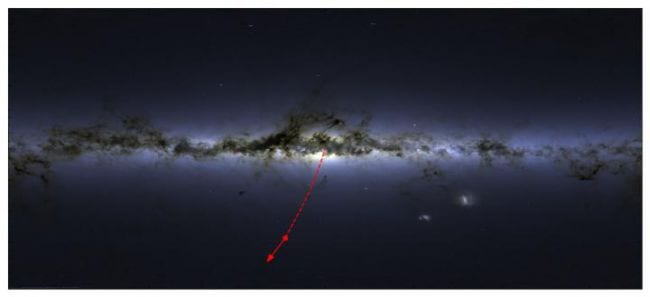A Rejected Star from the Milky Way’s Supermassive Black Hole Took 5 Million Years to Come Near Earth
November 15, 2019
by Andreea Sterea
Sagittarius A*, the supermassive black hole at the center of our Milky Way, ejected a star at a mind-blowing 3.7 million mph speed. Now scientists have spotted this super-speedy rejected star traveling quite close to Earth.
The Supermassive Black Hole’s Rejected Star S5-HVS1 Is Traveling At Super Speeds
Researchers spotted the booted star a few days ago in the constellation Grus. It travels at around six million kilometers per hour, or 1,700 kilometers per second and it right in our neighborhood (29,000 light-years away from Earth is, basically, next door according to astronomical standards).
According to the press release, the star is traveling 10 times faster than most other high-velocity stars in the galaxy. The discovery belongs to scientists at Carnegie Mellon University’s McWilliams Center for Cosmology as part of the Southern Stellar Stream Spectroscopic Survey (S5). As expected, the experts are having a field day.
This is super exciting, as we have long suspected that black holes can eject stars with very high velocities. However, we never had an unambiguous association of such a fast star with the galactic center,
said Sergey Koposov, lead researcher of this study.
Now that the researchers spotted the star, they can understand more and more about it.
How Do We Know Where the Rejected Star Comes From?
Since the spotting, the researchers managed to track back the star’s trajectory back to the Sagittarius A* (Sgr A*). According to the study,
When integrated backwards in time, the orbit of the star points unambiguously to the Galactic Centre, implying that S5-HVS1 was kicked away from Sgr A* with a velocity of ∼1800 km s−1 and travelled for 4.8 Myr to its current location. This is so far the only HVS confidently associated with the Galactic Centre.
But what does this mean?
According to scientists, this discovery proves the Hill Mechanism proposed by by astronomer Jack Hills three decades ago. The model explains that when a black hole in the center of a galaxy interacts with a binary-star system, the impact leads to the rejection of a star from the center of that galaxy at incredible high speeds.

What Can We Learn From the Rejected Star’s Story?
First things first, we have to understand how the supermassive black hole rejected the star. Researchers believe that the star got too close to Sagittarius A* and the black hole did what black hole does (when it doesn’t send us messages, that is): it absorbed the star and gave it one helluva boot out of there.
According to Ting Li, a fellow at the Carnegie Observatories and Princeton University, leader of the S5 collaboration
This is the first clear demonstration of the Hills Mechanism in action. Seeing this star is really amazing as we know it must have formed in the galactic center, a place very different to our local environment. It is a visitor from a strange land.
The Rejected Star Can Teach Us New Things about the Universe
The world was surprised to learn not long ago that we hosted a supermassive black hole at the center of the Milky Way. Next, we were baffled to learn that the black hole flared up in what we believed back then it was a message. Now, the same Sagittarius A* keeps the science community on its toes again. The rejected star can teach us a lot about how black holes behave, adding proof or denying theoretical models of the past.
In the words of Kyler Kuehn, deputy director of technology at the Lowell Observatory,
While the main science goal of S5 is to probe the stellar streams — disrupting dwarf galaxies and globular clusters — we dedicated spare resources of the instrument to searching for interesting targets in the Milky Way, and voila, we found something amazing for ‘free.’ With our future observations, hopefully we will find even more!
We also hope this project and the people behind it will learn more, because, let’s face it, it is a great time to be alive when one can update its list of strange facts about space on a daily basis!
Want more science now?
Check out our news page where we post interesting studies and discussions (sometimes mocking them mercilessly) for more.
